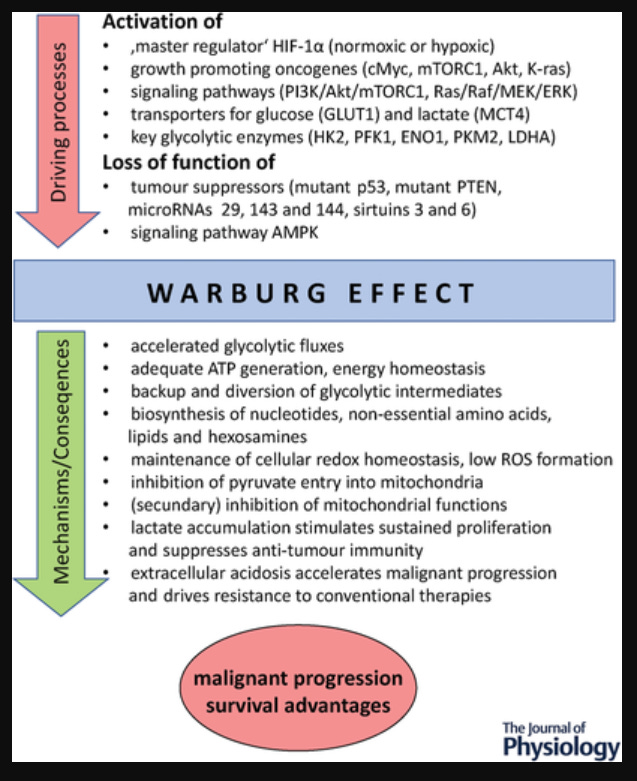The Spike Protein, The Warburg Effect and Carcinogenesis
A Molecular Preset for Inducing Cancer
If you are ever fortunate enough to play large pipe organs, you will quickly learn that modern instruments are, like everything else, are computer controlled. You can select a combination of stops, program them to be pulled together, press a button mid-performance and Voila, the stops you want pulled are instantly activated. This is called a preset.
What I have discovered is that the Spike Protein essentially performs the same task with “pulling the stops” that allow for the fastest, easiest and most efficient way to induce cancer. This is based upon the induction of the Warburg Effect.
First, let us look at what allows the Warburg Effect to initiate.
The Warburg phenotype constitutes a metabolic signature of 70–80% of human cancers, which results from the interplay between the normoxic/hypoxic activation of the transcription factor hypoxia-inducible factor-1 (HIF-1), oncogene activation, loss of function of tumour suppressors, altered signalling pathways and interaction with components of the tumour microenvironment (TME), sometimes working in concert with epigenetic mechanisms. The Warburg effect reflects a metabolic programme of cancer cells driving sustained proliferation and accelerating malignant progression (Vaupel et al. 2019).
Revisiting the Warburg effect: historical dogma versus current understanding
https://physoc.onlinelibrary.wiley.com/doi/10.1113/JP278810
The above is precisely what the Spike Protein induces.
1) Activation of HIF-1
Our immunofluorescent staining data showed that when compared to the untreated control, treatment of microglia with recombinant SARS-COV2 spike protein leads to a 57% increase (p < 0.05) in HIF-1α expression.
Mitochondrial Dynamics in SARS-COV2 Spike Protein Treated Human Microglia: Implications for Neuro-COVID
https://link.springer.com/article/10.1007/s11481-021-10015-6
2) Loss of function of tumor suppressors
Here, we have investigated the interaction of S2 subunit to tumor suppressor and cell cycle-related proteins. HADDOCK 2.2 software was used to analyze the interaction and found that S2 subunit of SARS-nCov-2 strongly interacts with p53 and BRCA-1/2 proteins. p53 and BRCA are the well-known tumor suppressor proteins, that regulate downstream genes in response to numerous cellular stress and are frequently mutated in human cancer.
S2 Subunit of SARS-nCoV-2 Interacts with Tumor Suppressor Protein p53 and BRCA: an In Silico Study
https://www.ncbi.nlm.nih.gov/pmc/articles/PMC7324311/
3) Altered signalling pathways
In this review, we highlight the clinical and molecular similarities between cancer and COVID-19 and summarize the four major signaling pathways at the intersection of COVID-19 and cancer, namely, cytokine, type I interferon (IFN-I), androgen receptor (AR), and immune checkpoint signaling.
The intersection of COVID-19 and cancer: signaling pathways and treatment implications
https://molecular-cancer.biomedcentral.com/articles/10.1186/s12943-021-01363-1
4) Interactions with components of the tumor microenvironment
Mechanistically this association seems logic as the interaction between the host immune environment and cancer or SARS-CoV-2 infections uses similar pathways in advanced disease settings.
SARS-CoV-2 and cancer: Are they really partners in crime?
https://www.cancertreatmentreviews.com/article/S0305-7372(20)30106-7/fulltext
5) The Warburg Effect itself
The infection by Covid-19 follows a similar pattern. Long-term effects include redox shift and cellular anabolism as a result of the Warburg effect and mitochondrial dysfunction.
Toxicity of the spike protein of COVID-19 is a redox shift phenomenon: A novel therapeutic approach
https://www.sciencedirect.com/science/article/pii/S0891584923005014
Why I believe we need to pay particular attention to this is that the Warburg Effect itself may not only be the metabolic product of active cancer but may also induce cancer itself.
Unlike Warburg's initial hypothesis that cancer cells metabolize glucose through aerobic glycolysis due to impaired mitochondrial function a new hypothesis was presented that the normal cell becomes cancerous at the point when it switches its glucose metabolism from oxidative phosphorylation to aerobic glycolysis. The new hypothesis that Warburg effect corresponds to the very beginning of carcinogenesis might be supported by the eventual failure in synthesis of the PDC. Such failure could be mediated by one (or multiple) of the well-known carcinogenic factors in synergy with an excessive supply of glucose in carbohydrates rich diets.
Warburg Effect - a Consequence or the Cause of Carcinogenesis?
https://www.ncbi.nlm.nih.gov/pmc/articles/PMC4860798/
There’s that carbohydrate rich diet again. We should be thankful that everything with the Spike Protein is completely logical – once we understand it fully. This all ties into what I published back in 2021.
Could diet and exercise reduce risk of COVID-19 syndemic?
Walter M. Chesnut, Scott MacDonald, Carlos Gustavo Wambier
https://www.sciencedirect.com/science/article/pii/S0306987721000207
I recommended that Long COVID patients have full body PET scans. I believe identifying and tracking areas of Warburg Effect is necessary. To what extent is the Spike Protein inducing cancer? Is it self-limiting? Does it spread aggressively? How long is metabolism impaired for? There are so many questions to which we need answers.
Fasting and eating a truly healthy, balanced and thoughtful diet may be as important as the therapeutics we take in keeping the Spike Protein at bay. I will keep working to find answers for those who may already have made the shift to a pro-cancer metabolism.
As always, your support is what allows me to work.




Have you done any research on fenbendazole? There is some evidence that it can eviscerate cancer.
Important observations here. This needs to be spread far and wide.